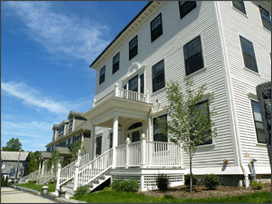In 2007, Boston Mayor Thomas Menino made history by ratifying Article 37 which states that all private buildings larger than 50,000 square feet, as well as those requiring zoning relief, be LEED (Leadership in Energy and Environmental Design) certified. In so doing, he made Boston the nation's first city to mandate such a requirement. To ensure that similar standards also apply to affordable housing, the city's Department of Neighborhood Development (DND) created a set of guidelines as part of its Green Affordable Housing Program (GAHP). This article will focus on how GAHP has developed its own standards to create an affordable housing green building code.
 GAHP Green Standards GAHP Green Standards
Although the DND's original code contained some "green" elements, according to DND Senior Development Officer John Feuerbach, two key events inspired the Department to take its guidelines much further. The first was Article 37, which encouraged DND to initiate its own green programming. The second was a $2 million grant from the Massachusetts Green Energy Center (a quasi-governmental technology firm), which the DND received in 2007 to implement green goals. Awarded as part of the Green Energy Center's Green Affordable Housing Initiative, the grant was earmarked to support development of green affordable housing in Boston.
In terms of construction and gut renovation, GAHP's new guidelines require that developments meet ENERGY STAR standards, which are set by the Environmental Protection Agency and the Department of Energy, as well as the LEED Silver standards set by the U.S. Green Building Council. Obtaining "official" LEED certification can be costly and time consuming, thus the DND evaluates developments in-house to assess whether they meet LEED standards.
GAHP's new guidelines also establish three objectives that housing must meet. First, developments must include sustainable design elements and technologies, like solar arrays and cool roofs. Residents can benefit directly from such features, which help decrease maintenance and energy costs.
 Second, developments must be designed to foster healthier homes. Moisture, mold, and poor ventilation heighten the risk of allergic reactions and asthma attacks; these same elements can attract cockroaches and mice, which in turn trigger allergies and worsen upper respiratory diseases. As a result, the DND has called for housing specially designed to remain dry and properly ventilated. The enhanced indoor air quality that commonly results in such environments has the added benefit of enabling DND to achieve its goals of reducing asthma and other respiratory problems, which occur at particularly high rates in some Boston neighborhoods. Second, developments must be designed to foster healthier homes. Moisture, mold, and poor ventilation heighten the risk of allergic reactions and asthma attacks; these same elements can attract cockroaches and mice, which in turn trigger allergies and worsen upper respiratory diseases. As a result, the DND has called for housing specially designed to remain dry and properly ventilated. The enhanced indoor air quality that commonly results in such environments has the added benefit of enabling DND to achieve its goals of reducing asthma and other respiratory problems, which occur at particularly high rates in some Boston neighborhoods.
The third objective is to minimize developments' environmental impact. In the United States, buildings account for over 65 percent of total electricity consumption and use 12 percent of potable water, in addition to producing significant amounts of air pollution, municipal waste, and carbon dioxide emissions. Energy-efficient and sustainable design elements, such as gardens that trap rainwater and low-flow toilets, result in buildings that release fewer emissions and consume fewer natural resources.
Conclusion
Collaborating with a governmental, nonprofit, or private green technology firm is an innovative way to secure funds for affordable housing that promotes renewable energy and sustainable design. These same technologies and design strategies may also result in lowered maintenance and energy costs, and can potentially improve residents’ respiratory health and well-being.
Previous Search Archive
|


